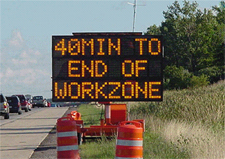Intelligent Transportation Systems (ITS) & Technology


Transportation agencies across the country are using ITS to make travel through and around work zones safer and more efficient. ITS involves the use of electronics, computers, and communications equipment to collect information, process it, and take appropriate actions. ITS technology can be applied in work zones for:
- Traffic monitoring and management
- Providing traveler information
- Incident management
- Enhancing safety of both the road user and worker
- Increasing capacity
- Enforcement
- Tracking and evaluation of contract incentives/disincentives (performance-based contracting)
- Work zone planning
Many ITS applications in work zones serve a combination of the above purposes.

Information, tools, and resources on FHWA's Every Day Counts Smarter Work Zone Technology Applications Initiative.
This page provides a number of resources for implementing various types of ITS in work zones:
- ITS in Work Zones Case Studies and Assessments
- Automated Work Zone Information Systems
- Traffic Management Systems
- Portable Changeable Message Signs (PCMS)
- Work Zone ITS Deployment Examples
- Additional Work Zone ITS Resources
- General ITS Resources
ITS in Work Zones Case Studies and Assessments
- Comparative Analysis Report: The Benefits of Using Intelligent Transportation Systems in Work Zones (HTML, PDF 1.5MB) - Provides insights into the mobility and safety benefits of using ITS for work zone traffic management, as well as tips, and lessons learned. The information presented is based on an FHWA study that examined five case study sites: I-40 outside Winston-Salem in North Carolina; I-30 between Benton and Little Rock in Arkansas; US-131 in Kalamazoo, Michigan; I-35 in Hillsboro, Texas; and DC-295 in Washington, DC.
- Benefits of Using Intelligent Transportation Systems in Work Zones: A Summary Report (HTML, PDF 810KB) - Summarizes the results of a quantifiable assessment of the effectiveness of ITS in work zones, as well as tips and lessons learned. Five sites participated in the study: I-40 outside Winston-Salem in North Carolina; I-30 between Benton and Little Rock in Arkansas; US-131 in Kalamazoo, Michigan; I-35 in Hillsboro, Texas; and DC-295 in Washington, DC.
- FHWA Case Studies
- Mitigating Work Zone Safety and Mobility Challenges through Intelligent Transportation Systems: Case Studies (HTML, PDF 2.5MB) - Describes how five sites used ITS to mitigate work zone safety and mobility issues and illustrates how to apply a systems engineering-based decision-making process to designing, selecting, and implementing a system.
Additional Work Zone ITS Resources
- Real-Time Integration of Arrow-Generated Work Zone Activity Data into Traveler Information Systems (HTML, PDF 1.3MB) - This fact sheet provides information on using Connected Arrow Boards, by the Minnesota Department of Transportation, to improve traveler information and lane closure information accuracy.
- Work Zone Intelligent Transportation Systems - Technology Supplement(PDF 2.4MB) - This report represents a technology supplement to the 2014 Work Zone Intelligent Transportation Systems (WZITS) Implementation Guide (Report No. FHWA-HOP-14-008). The purpose of this document is to supplement the original Guide with this information, and includes factsheets and specification sheets for nine WZITS technologies.
- Smarter Work Zones: Alternative Funding for Work Zone ITS Fact Sheet (HTML, PDF 344KB) - This fact sheet focuses on the Illinois Department of Transportation's (IDOT) use of Highway Safety Improvement Program (HSIP) funds to deploy technology applications in work zones.
- Guidance on Using Traffic Management Centers for Work Zone Management (HTML, PDF 1.6MB) - This document presents guidance for DOTs to consider how Traffic Management Center (TMC) resources (staff, data, and tools) can be used to support all stages of a work zone, providing examples of where these resources are used today. A total of eight strategies are presented for utilizing TMC resources during the four stages of a work zone. Each strategy includes detailed descriptions and examples of use in practice.
- Work Zone Intelligent Transportation Systems (ITS) – Held on January 30, 2014
- Recording
- Transcript
- Overview of Work Zone ITS and New FHWA Resources, by Tracy Scriba, FHWA
- Work Zone ITS Implementation Guide, by Jerry Ullman, Texas A&M Transportation Institute
- ITS Work Zone Experiences in Southern Illinois, by Ted Nemsky, Illinois Department of Transportation
- Work Zone ITS Information Resources
- Work Zone Intelligent Transportation Systems Implementation Guide (HTML, PDF 1.8MB) - The purpose of this document is to provide guidance on implementing ITS in work zones to assist public agencies, design and construction firms, and industry, including developers, manufacturers, distributors, packagers, and providers of devices, systems, and programs. Work zone ITS is one possible operational strategy of many potential solutions that an agency can include in a transportation management plan (TMP).
- ITS for Work Zones Leaflet: Deployment Benefits and Lessons Learned - Summarizes the benefits, costs, extent of deployment, and lessons learned about using ITS in work zones.
PDF files can be viewed with the Acrobat® Reader®
PPT files can be viewed with the Microsoft PowerPoint Viewer.
DOC files can be viewed with the Microsoft Word Viewer.
WMV files can be viewed with the Windows Media Player.
